
Transcription
Progression in EmploymentApril 2019Report 518
2Progression in Employment: Purpose and AimsInstitute for Employment StudiesIES is an independent, apolitical, international centre of research and consultancy inpublic employment policy and HR management. It works closely with employers in allsectors, government departments, agencies, professional bodies and associations. IES isa focus of knowledge and practical experience in employment and training policy, theoperation of labour markets, and HR planning and development. IES is a not-for-profitorganisation.About this reportThis report is published by IES with the support of JPMorgan Chase Foundation undertheir global New Skills at Work initiative.While this report has been supported by the JPMorgan Chase Foundation, the contentsand opinions in this paper are those of IES alone and do not reflect the views of theJPMorgan Chase Foundation, JPMorgan Chase & Co, or any of its affiliates.Institute for Employment StudiesCity Gate185 Dyke RoadBrighton BN3 1TLUKTelephone: 44 (0)1273 763400Email: askIES@employment-studies.co.ukWebsite: www.employment-studies.co.ukCopyright 2019 Institute for Employment StudiesIES project code: 01023-4975
Institute for Employment Studies3Background and PurposeThe Progression in Employment project is designed to capture evidence and insights ondeveloping and implementing upskilling pathways for low-skilled adults within four criticalsectors (Retail, Hospitality, Health and Social Care) across six countries (Sweden, UK,France, Germany, Italy and Spain). The project is identifying effective employer practicein supporting the in-work progression of low-skilled adults, and aims to share the learningwidely to inform and influence employer policy and practice.Defining progressionProgression can be defined and measured in different ways. Perhaps the simplest is interms of earnings progression, but there are other ways too. Moving from insecure tomore secure employment or improved socioeconomic status can also be viewed asprogression. Similarly, moving to a role with greater (management) responsibility or whichrequires a greater level of skill or qualification can represent progression. Improving jobquality across a number of other dimensions can also be viewed as a measure ofprogression (minimum guaranteed hours; use of skills and neither under- or overemployment).Why progression in employment matters?Finding ways to support the progression of low-skilled workers is important not just forindividuals themselves, but also for businesses and the wider economy. At least threearguments can be articulated that resonate at these different levels of economic activity: The Anti-poverty case – progressing in work is a key way in which in-work poverty canbe alleviated. Whilst not all low-skilled workers will be in poverty as a result of widerhousehold incomes, many will be and progression in work can enable higher incomesand help lift people out of poverty. The business case – businesses theoretically should benefit from higher skills sincethis enables higher productivity and better return on capital investment. Businessesmay also benefit from reduced turnover and recruitment costs, and the reputationalbenefits of being perceived as a good employer. The Wider economy case – raising the skills of the workforce should raise productivityand ultimately the GDP of the country. Raising productivity should also, theoretically,lead to higher pay levels.Despite the potential benefits of supporting in-work progression for individuals, employersand society more generally, there are lots of indications that there are challenges inmaking progression a reality. Market pressures and fluctuations in demand may leademployers to adopt a low-cost, low-value business model with low investment in Institute for Employment Studies3
4Progression in Employment: Purpose and Aimsemployees. That said, evidence suggests that employers might adopt quite differenthuman resource models even when we faced with the same set of market pressures.Similarly, other research suggests that even when competing on price, not investing inemployees can be a false economy due to increased indirect costs from employeeturnover and low staff satisfaction (Ton, 2014)1.What are employers doing?Employers are taking a wide range of actions to support progression of low-skilledworkers. Examples of employer practice to facilitate progression include: The redesign of jobs to facilitate the progression of part-time workers intomanagement roles; Structured career development pathways mapping different roles, the competenciesrequired in different roles, and the training and development opportunities thatfacilitate movement between the roles; Contracted minimum hours to address underemployment and reduce costly turnover; The creation of specialist roles, training and pay associated with these roles; Multi-organisation collaborations to support individuals to build a career within aparticular sector; Regular career conversations and the development of line management capability.Case Study Example: Scandic Hotels, SwedenAs a result of the high growth rate in the hospitality sector in Sweden and increasedcompetition for talent, Scandic, the biggest hotel company group in Scandinavia, hastaken steps to support in-work progression and retain talented employees. Scandichas recognised the importance of employer reputation in such a tight labour market.In-work progression at Scandic is supported in multiple ways: Each Scandic hotel is operated in a similar way and each employee is systematicallyinformed about different progression routes Regular performance reviews and constructive feedback is used as an effective toolfor mapping different career pathways and directions for each individual within thecompany1Zeynep Ton (2014) The Good Jobs Strategy: How the smartest companies invest in employees to lowercosts and boost profits. MIT Sloan School of Management.
Institute for Employment Studies5 Job opportunities are listed first on the company Intranet. The company also has atarget of staffing each new hotel with 50% internal recruitment to help ensure thatcompany values and culture are evident in each new hotel Cross-training is encouraged enabling employees to learn new skills and experiencedifferent roles and opportunities within the company A ‘Future Leaders’ programme open to all Scandic employees. Through thisprogramme, Scandic can meet its target of recruiting 100-150 managers per year. In-work progression has increased the knowledge and skills of staff and enhancedretention, generating savings in recruitment costs. It has also enabled greater mobilitywithin the organisation and improved service delivery.What are the benefits?Our research to date has identified a range of benefits for employers. These include: reduced turnover and recruitment costs; improved retention and addressed skill shortages; improvements to service quality and consistency; and enhanced employer brand and reputation.What factors enable successful implementation?Our evidence suggests that to implement initiatives successfully, leaders and HRprofessionals need to think about: Development of an evidence-base and business case for the progression of lowskilled workers, for example as a means of supporting the growth of the organisation,improving service quality, or reducing costs associated with staff turnover andsickness absence; Senior leadership support for the progression agenda making it part of high-profilepolicy; Developing champions throughout the business to develop, implement and sustainprogression practices; The presence of HR systems and practices such as induction, performanceappraisals, (personal) development provision; A long-term perspective helps, with organisations anticipating future skills needs morelikely to identify opportunities for progression for their staff. Institute for Employment Studies5
6Progression in Employment: Purpose and AimsUsing Nudge insights to support employer practice?Our research to date has also looked at how behavioural insights or ‘nudge’ approachescan support the progression of low-skilled employees. Behavioural insights combine anunderstanding of economics and psychology to consider how people make decisions, andhow those decisions can be influenced. Applying these insights to encourage individualstowards a particular behaviour is commonly known as ‘nudging’. It has gained increasedattention in recent years by policymakers in particular as it offers a cost-effective way toinfluence citizens’ behaviour in a non-coercive way. It is also increasingly gainingprominence in the HR world, with a number of books and papers published on how toapply behavioural insights to support the progression of disadvantaged groups withinindividual employers.A review of the research evidence identified at least three different types of ‘nudge’ thatcould be applied to support in-work progression. ‘Feel the need’ – raising the level of personal awareness of one’s own bias with aview motivate individuals to monitor bias when making decisionsHighlighting bias in recruitment and promotion2A simple exercise can be an effective way of highlighting cognitive bias to interviewers before arecruitment or promotion round. In this exercise, a group of interviewers are each given the CVof a fictional candidate to assess. The candidates must have identical CVs but different pictures,names, race and gender. Each interviewer must individually assess and rate each candidate.The group are then shown the variation in ratings, before it is revealed that all their candidatesare equally suitable for the role. This can prompt interviewers to realise that their evaluation ofcandidates may have been influenced by their individual characteristics rather than theirqualification for the role. Process change – changing the decision-making architecture to encourage thedesired behaviourUsing joint evaluation to overcome biasResearch shows that bias is more likely to be present when a candidate is evaluated individuallycompared to when they are evaluated alongside other candidates. When they are evaluatedagainst others, interviewers are more likely to focus on applicants’ past performance andcompetencies, rather than individual characteristics. Organisations can change their recruitmentprocess to make group evaluation more common, and make it procedurally difficult forinterviewers to assess one candidate at a time.2Nielsen C and Kepinski L (2016) Inclusion Nudges Guidebook, 2ndEdition
Institute for Employment Studies7 Framing – using language to frame the way people think about an opportunity ordecision.Reframing the job specification to encourage more diverse applicant poolSome individuals may be deterred by the language used to advertise work opportunities, whichmay be read as designed to attract a particular gender, age or ethnicity. Stating all thedemographics that the opportunity should apply to clearly in the text or title of the opportunity,encourages a more diverse pool to apply.For example, a job description could state “We are looking for a female or male motivatedtalent”, rather than “We are looking for motivated talent”. This can help to shift stereotypesattached to some roles.In supporting the progression of low-skilled workers in the workplace, the evidencesuggests a number of actions could be taken including: Critically evaluating promotion criteria for evidence of exclusion and bias and updatingall promotion criteria by removing any unnecessary requirements; Ensure that all individuals involved in the promotions process are trained inunconscious bias; Create a workplace environment where those involved in the promotion process feelcomfortable discussing and challenging perceived biases – both individual andorganisational; In selecting candidates for promotions, include all remotely eligible people on a listrather than relying on a mental list, which may be subject to corruption by implicitbiases. “Ask “Why not?” instead of assuming that they are not ready or interested”(Nalty Consulting; year unknown:p.11); Involve many different types of people from different positions in the promotionprocess so that there are a wide variety of perspectives; Standardise the promotion process to eliminate subjectivity and reduce unconsciousbias.Final thoughtsFuture phases of the project will collate additional in-depth examples of employer practiceand develop a toolkit to support leaders and HR professionals to know what they can doto support the progression of low-skilled workers. The toolkit will be launched at aconference in November 2019 to share learning and develop practice. For further detailsabout the project, toolkit and conference, please contact the study leads, Dan Lucy(dan.lucy@employment-studies.co.uk) and Dr Zofia Bajorek (Zofia.bajorek@employmentstudies.co.uk). Institute for Employment Studies7
While this report has been supported by the JPMorgan Chase Foundation, the contents and opinions in this paper are those of IES alone and do not reflect the views of the JPMorgan Chase Foundation, JPMorgan Chase & Co, or any of its affiliates. . Job opportunities are listed first on the company Intranet. The company also has a










